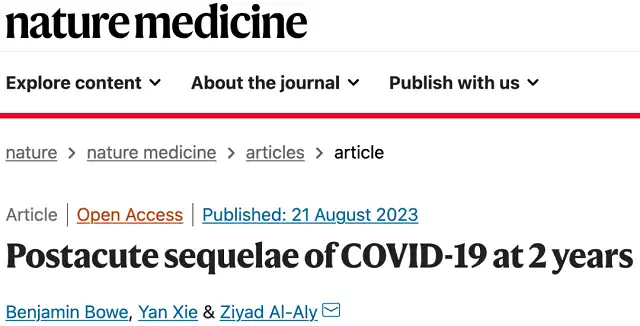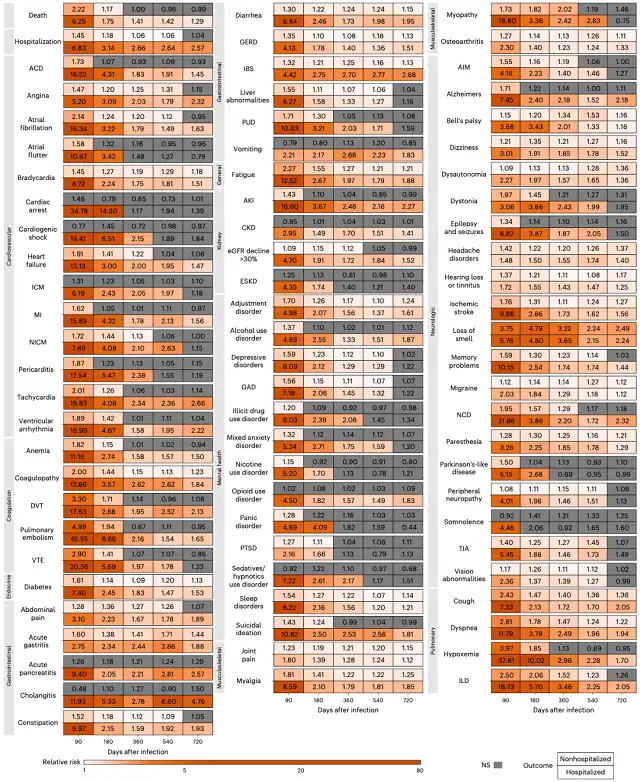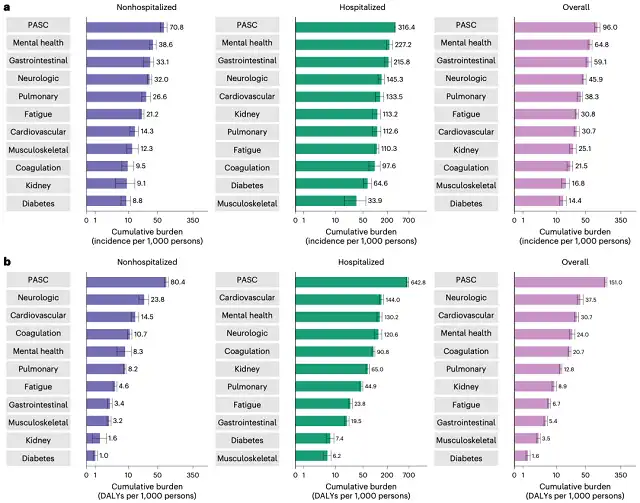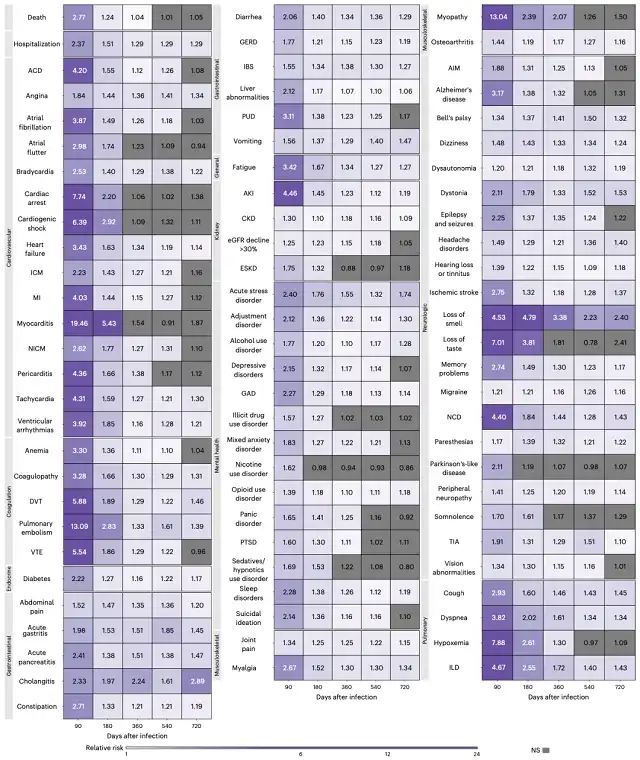Risk of 48 Post-Acute Sequelae of COVID-19 Increases Two Years After Infection
- Why Lecanemab’s Adoption Faces an Uphill Battle in US?
- Yogurt and High LDL Cholesterol: Can You Still Enjoy It?
- WHO Releases Global Influenza Vaccine Market Study in 2024
- HIV Infections Linked to Unlicensed Spa’s Vampire Facial Treatments
- A Single US$2.15-Million Injection to Block 90% of Cancer Cell Formation
- WIV: Prevention of New Disease X and Investigation of the Origin of COVID-19
Risk of 48 Post-Acute Sequelae of COVID-19 Increases Two Years After Infection
- Red Yeast Rice Scare Grips Japan: Over 114 Hospitalized and 5 Deaths
- Long COVID Brain Fog: Blood-Brain Barrier Damage and Persistent Inflammation
- FDA has mandated a top-level black box warning for all marketed CAR-T therapies
- Can people with high blood pressure eat peanuts?
- What is the difference between dopamine and dobutamine?
- How long can the patient live after heart stent surgery?
“Nature Medicine”: Risk of 48 Post-Acute Sequelae of COVID-19 Increases Two Years After Infection | Clinical Discovery
COVID-19 is here to stay.
Lately, there have been reports of people testing positive for the virus in my social circle, and I’ve been experiencing symptoms similar to a severe cold for a couple of weeks myself.
I’m not sure if this is due to Post-Acute Sequelae of COVID-19 (PASC), but I’ve definitely noticed that my recovery this time is slower.
This week, Ziyad Al-Aly’s team from Washington University in St. Louis published a study in the prestigious journal “Nature Medicine” on the status of Post-Acute Sequelae of COVID-19 (PASC) two years after infection [1].
They analyzed two years of follow-up data from over 6 million individuals and found that for COVID-19 patients who did not require hospitalization, their risk of death decreased to the level of non-infected individuals after six months. However, for those who needed hospitalization, their risk of death increased within two years of infection.
Additionally, among the 80 sequelae included in the study, two years after COVID-19 infection, infected individuals still had a 60% (48/80) increased risk of sequelae compared to those who were not infected. Specifically, for non-hospitalized COVID-19 patients, 31% continued to experience sequelae even two years after infection, while this number rose to a staggering 65% for hospitalized COVID-19 patients.
It’s clear that the long-term impact of COVID-19 infection is significant.

Screenshot of the paper’s cover page
There’s already substantial research indicating that COVID-19 infection can lead to acute sequelae in organs such as the lungs, increasing the risk and burden of lung diseases, cardiovascular diseases, neurological/psychiatric disorders, metabolic diseases (diabetes and lipid abnormalities), and gastrointestinal diseases.
However, there is currently limited comprehensive research on the burden of PASC two years after COVID-19 infection, and there is no research regarding differences in PASC burden between non-hospitalized and hospitalized COVID-19 patients. To fill this gap, Al-Aly’s team initiated this large-scale, long-duration retrospective study.
The study population included individuals from the U.S. Department of Veterans Affairs, comprising 138,818 COVID-19 patients (of which 118,238 were non-hospitalized and the remaining 20,580 were hospitalized, with 11.41% being female and an average age of 62.82 years), and 5,985,227 non-infected individuals (9.93% female with an average age of 62.82 years). The study covered a total of 80 sequelae.
Let’s first look at non-hospitalized COVID-19 patients.
Compared to the control group, non-hospitalized COVID-19 patients still had an increased risk of death within 91-180 days after infection, but their risk did not increase within 181-720 days after infection.
For hospitalized COVID-19 patients, the risk of hospitalization increased within 361-540 days after infection, but there was no increase in hospitalization risk within 541-720 days after infection. Clearly, hospitalized patients were more affected in terms of death risk.
Regarding the 80 sequelae covered in the study, 69% of the sequelae diminished to non-significant levels for non-hospitalized COVID-19 patients two years after infection.
However, 31% (24/77) of the sequelae remained significant. Specifically, compared to the control group, non-hospitalized COVID-19 patients still had increased risks of blood and coagulation system diseases, lung diseases, fatigue, gastrointestinal diseases, musculoskeletal diseases, and diabetes two years after infection.

Changes in different sequelae for hospitalized and non-hospitalized COVID-19 patients over time
Now, let’s consider hospitalized COVID-19 patients.
Compared to non-hospitalized patients, the risk reduction for hospitalized patients was much less. Two years after infection, hospitalized COVID-19 patients still experienced 65% (50/77) of the sequelae compared to the control group, with only 35% of the sequelae no longer affecting them.
Specifically, 57% of cardiovascular sequelae, 80% of blood and coagulation sequelae, all endocrine sequelae, 82% of gastrointestinal sequelae, 75% of kidney sequelae, 38% of mental health sequelae, 75% of musculoskeletal sequelae, 60% of neurological sequelae, and all lung sequelae continued to affect hospitalized COVID-19 patients.

Burden of sequelae
If we look at all COVID-19 patients, regardless of whether they required hospitalization, after one year of COVID-19 infection, there was an increase in the risk of death and hospitalization, and 86% (69/80) of the sequelae risks remained elevated.
After two years of COVID-19 infection, there was an increase in hospitalization risk, and 60% (48/80) of the sequelae risks remained elevated.

Changes in different sequelae for COVID-19 patients over time
In summary, the research by Al-Aly’s team indicates that while the risk of many acute sequelae of COVID-19 decreases over time and even disappears for some patients, this decline is not significant for patients who required hospitalization during the acute phase of the infection.
This suggests that Post-Acute Sequelae of COVID-19 will pose a significant cumulative burden on human health.
Therefore, the team emphasizes the need to address the care requirements of individuals who are experiencing long-term health issues due to COVID-19 infection.
Risk of 48 Post-Acute Sequelae of COVID-19 Increases Two Years After Infection
Reference:
[1]. Bowe B, Xie Y, Al-Aly Z. Postacute sequelae of COVID-19 at 2 years. Nat Med. 2023;10.1038/s41591-023-02521-2. doi:10.1038/s41591-023-02521-2.
(source:internet, reference only)
Disclaimer of medicaltrend.org
Important Note: The information provided is for informational purposes only and should not be considered as medical advice.



